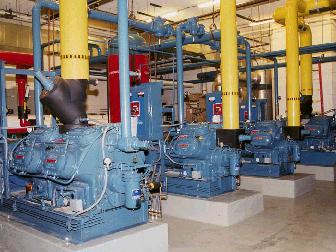Overview

Refrigeration units differ from chillers in that refrigeration units are designed for below freezing and typically below zero applications (chillers typically operate at 42 – 45F).
Refrigeration units will often use ammonia instead of an HCFC. Ratings are typically given in horse power instead of tons. Other than that, much of what could be said about chillers can be said for engine driven refrigeration units.
There are a few companies that will custom make engine-driven refrigeration units using any gas engine and compressor. TecoFROST is currently the only ‘off-the-shelf’ packager of standard systems. See the Case Studies below for information on installations that are using TecoFROST, Caterpillar and Cummins engines.
Operation
Like chillers, refrigeration units can be rated in Tons, where 1 Ton = 12,000 BTUs moved. However, refrigeration units operate at much lower temperatures (below zero) instead of in the 45F degree range like chillers. Therefore, it takes a lot more input energy to produce a ton of refrigeration than it does to produce a ton of cooling. For example, an engine that may produce 150 tons when in a chiller application, will only produce about 90 Tons when in a refrigeration application (the TecoDrive auto-derivative engine). This is why it is more common to discuss refrigeration systems in terms of Horse Power than Tons.
Refrigeration operating conditions are defined by their Suction and Discharge Temperatures and Pressures. Suction is the warmest temperature of the refrigeration fluid entering the compressor, and Discharge is what the compressor has done with it. The colder the operating temperature and the higher the pressure range, the more horse power will be required to produce the same amount of cooling. Therefore, refrigeration systems are sized according to their operating temperature and pressure range and the total refrigeration load they will be required to move.
The most common refrigeration compressor is the reciprocating unit (pistons). This type of compressor responds well to a variable speed drive, and therefore works well with a variable speed natural gas engine.
How the compressor load is controlled can have a major effect on the operating cost, both gas and electric. Older controls simply varied an outlet valve on the compressor’s refrigeration fluid to change the output load. Newer controls shut-off individual cylinders of the compressor, which reduces the load on the drive. The newest and most efficient controls integrate the shutting off of cylinders with the shutting off of the drive, and/or use variable speed electric drives.
It is extremely important to understand the control system on the compressors before making assumptions about the savings potential with a switch to natural gas engines. Compressor systems that are lightly loaded (ie: a lot of the time cylinders and/or the motor drive is shut off) will get little or NO benefit from the variable speed aspect of an engine. The only potential advantage (savings) would be the fuel cost differences.
Further, because refrigeration systems are sized for peak-day loads but run year round, it is very important to understand the actual load profile. In the case of freezer, how product is moved in and out also dramatically affects refrigeration loads.
Economics
Because refrigeration systems usually run 24/7 all year, there are a high number of run hours. If the savings per hour is there, payback can be quite rapid. Most economic studies will show that gas units should be used in a hybrid system, with gas run only during the high cost hours, and electric base load units run the rest of the time. If there is a full time use/need for heat recovery, then it would probably make economic sense to run the gas unit to also match the thermal load.
The most difficult part of an analysis between gas and electric refrigeration systems, is determining the actual (estimating or measuring to the best of your ability) load profile of the refrigeration system. As discussed in Operations above, you need to understand the control system, the performance curves of the equipment in the given application, the daily and/or seasonal loads on the system, and the utility rate structures.
After you have a good understanding of the load profile of the refrigeration system, it becomes a matter of calculating the difference between electric drive and gas drive performance curves. For an existing installation, a good way to start is to create a spreadsheet model that estimates the electric usage and costs of the existing system, and then compare the model’s results to the actual electric bills. Once you are able to model the existing system, substitute the performance curve and operating costs of the gas unit, and compare the results.
Heat Recovery
If there is a need/value for heat recovery, calculate this additional savings potential only after you’ve determined the refrigeration savings. It will make no sense to install an engine drive system based only on the heat recovery savings. There are less expensive ways to generate heat. Generally, about 1/3 of the gas input energy can be recovered as usable waste heat, so long as it can be used as hot water. Larger engines can produce some low pressure steam, but it is a pretty small value compared to the cost to recover it.
First Cost
First cost of equipment is about twice that of electric.
TecoFROST Model 16 sells for about $65,000. Similar electric unit is $34,000
At $0.09 kW electric and $6.00 MCF gas, 6,000 hrs/yr (at full load), payback is 1.8 years w/o heat recovery. Maintenance is figured at $1.25 per EFLRH (Equivalent Full Load Run Hour)
For More Information
Manufacturers
TECOGEN
45 First Avenue
Waltham, MA 02451
Telephone: 781-466-6400
Web site: www.tecogen.com
